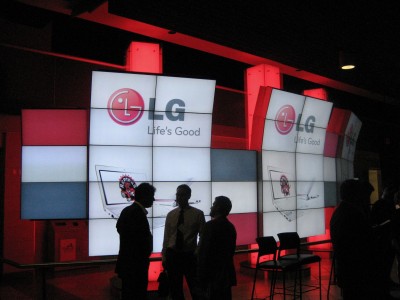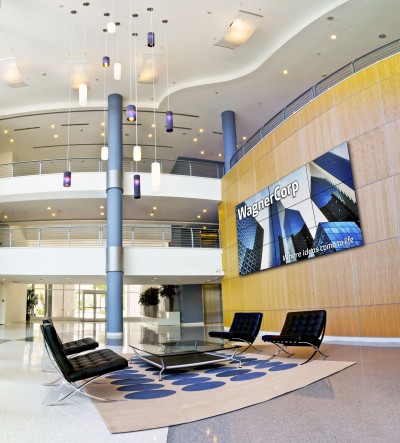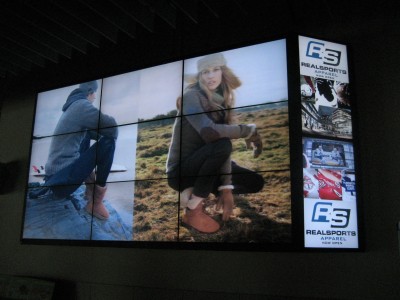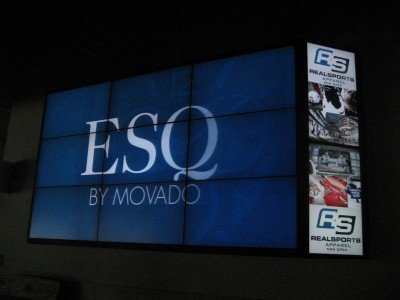Lessons for sustainable success
by Matthew | 21 January 2012 10:58 am
 [1]
[1]Photo by Peter Saunders
By Lyle Bunn
Digital signage has now achieved a certain critical mass, in terms of installed networks, refined technologies, supply chains and business processes, but its growth continues at a rapid rate. Recent market analysis reports from Frost & Sullivan, DisplaySearch, iSuppli, Allied Business Intelligence (ABI) Research, PQ Media and Northern Sky Research (NSR) have all roughly forecast a 20 per cent compound annual growth rate (CAGR) for display shipments, advertising and overall industry revenues.
“Every part of the industry needed to have enough sail up to catch its share of coming winds,” says Stuart Armstrong, president of digital signage platform developer ComQi and past-president of the Digital Screenmedia Association (DSA).
In North America alone, digital signage has grown into a $7-billion industry. With some 1.4 million displays installed across more than 600 networks—split roughly 50/50 into ad-based and corporate networks—the continent is ahead of Europe and Asia in the adoption of digital signage. A study by Arbitron in 2010 showed 70 per cent of U.S. residents—about 181 million people—had viewed digital displays in a given month.
With improvements in design, deployment and operations, the medium of digital signage has become highly influential and has won approval from an audience that now expects to see more sophisticated content. Some TV ads are even being pilot-tested on out-of-home (OOH) screens first.
 [2]
[2]Restaurants continue to represent one of the high-growth market segments for digital signage. Photos courtesy NEC Display Solutions
Digital signage is also taking on new forms that allow it to become more ubiquitous. While liquid crystal displays (LCDs) are being assembled into massive video walls, the industry is also seeing a rise in smaller-format displays, like digital photo frames installed on store shelves.
Focus of investment
Most of the inherent characteristics of digital signage have not changed. High-growth market segments for the medium continue to include retail stores, transit vehicles and stations, cinemas, stadiums, houses of worship, corporate offices, bars, restaurants, hospitals, campuses, hotels and casinos.
Notably, the cost of digital signage technology itself is dropping while the cost of operations is rising. Already, half of the North American market value comes from content development, rather than hardware or software. This is due to an increased focus on the relevance and context of content.
“We used to see lots of screens thrown up with no sense of ownership,” says Kim Sarubbi, president and CEO of Saddle Ranch Digital, a content developer. “Now we’re seeing companies taking a more holistic approach.”
“Digital signage is not about technology, it is about go-to-market know-how,” says
Chris Connery, VP of DisplaySearch’s personal computer (PC) and large-format commercial display market research group.
 [3]
[3]Architects and other designers of built spaces are now coming on board, helping to plan contextually relevant environments for digital signage.
“It takes planning, planning, planning,” says Steve Harris, vice-president (VP) and general manager (GM) of Cineplex Digital Solutions in Waterloo, Ont. “You have to get your strategy straight upfront.”
Certainly, in the wake of some failed past deployments, there is a lot more thoughtful planning today for digital signage networks. Each project’s objectives need to be defined early, so the right technology can then be applied to achieve those objectives.
A typical network deployment involves the following steps:
- Initial concept development (one to four weeks).
- Getting ‘buy-in’ from relevant stakeholders (two to six weeks).
- Network overview planning (one to 18 months).
- Pilot test and refinement (one to four months).
- Deployment and operations (four to 10 years).
“The value of digital signage does not decline, but increases over time when content messaging is refined,” says Paco Underhill, who studies the way people’s surroundings influence their behaviour. “Our visual language is evolving faster than our spoken words. We process images faster and it is a single language.”
Deeper integration
The most important factors for a successful digital signage network are for it to be reliable, available and scalable, i.e. supporting further network growth and adaptability. Digital signage lends itself to being paired or integrated with many other technologies and services, including safety and security alerts, mobile communications and training videos.
“We’ll see more screen integration with the rise of interactivity, social media and metrics,” says Nancy Biglow, marketing manager for digital signage software provider Scala Canada.
 [4]
[4]Advertisers are learning how best to develop and repurpose content for digital signage. Photos by Peter Saunders
In this sense, digital signage is part of a communications continuum, whereby multiple media are used to maximize the success—and minimize the costs—of a given communications effort. With a ‘transmedia’ approach, content created for use in one medium can be repurposed and reused for presentation through another medium, while maintaining consistency of branding and messaging.
Dynamic place-based media can communicate with an ‘audience of many,’ such as through out-of-home (OOH) advertising networks, but also reach a highly targeted ‘audience of one’ with refined content, based on demographics, locations and activities.
While many advertisers are increasingly recognizing the benefits of the medium as an effective way to communicate with targeted audiences, special technology is simultaneously being deployed to collect metrics. This trend is helping to build a stronger, evidence-based business case for the success of digital signage.
Measuring the impact of digital signage requires a combination of several metrics:
- Presence—The number of viewers in the area where the display is visible and, if appropriate, audible.
- Notice—Evidence that the viewers are actually noticing the display, through anonymous detection software.
- Dwell time—How long the viewers spend in the display area.
New audience-detection hardware and software have made all of these metrics possible, collecting continuous data about the audience for digital signage.
 [5]
[5] [6] Maple Leaf Sports & Entertainment’s (MLSE’s) digital signage team recently configured screens throughout the Real Sports Grill, reportedly the largest sports bar anywhere in North America, which sits adjacent to the Air Canada Centre in downtown Toronto.
[6] Maple Leaf Sports & Entertainment’s (MLSE’s) digital signage team recently configured screens throughout the Real Sports Grill, reportedly the largest sports bar anywhere in North America, which sits adjacent to the Air Canada Centre in downtown Toronto.
The players
Many audiovisual (AV) and information technology (IT) integrators, who already understand visual communications, are embracing the current generation of digital signage technologies. In some cases, their traditional business has been hurt by a declining market for digital projectors and other more typical AV products. In other cases, the motivation to switch gears comes from seeing some of their existing customers—in corporate communications, hospitality, food services, health care, retail and other sectors—adopt digital signage without their involvement.
“Dynamic signage investments are no longer considered optional or extravagant, but a requirement to meet expectations,” says Mike White, president of Multi-Media Solutions, a commercial display system integrator.
Some of the most recent players in the digital signage industry are traditional signmaking and wide-format printing companies, with some static signs being swapped out for dynamic displays.
“We’ve had success working with the sign business,” says Dave Spence, VP of business development for Coxcom, a digital signage installation company based in Mississauga, Ont. “Small networks have proven viable.”
Given the traditional sign and graphics industry generates an estimated $47 billion in North America, twice the size of the AV and IT integration market, there is a significant opportunity for technology suppliers and integrators to benefit from signmakers’ established content creation community and customer base.
Architects and other designers of built spaces are expected to be the next to come on board. They also represent a tremendous opportunity, as they can help plan contextually relevant environments for digital signage.
Lyle Bunn is a digital signage analyst, consultant, educator and adviser based in Brighton, Ont. For more information, visit www.lylebunn.com[7].
- [Image]: http://www.signmedia.ca/wp-content/uploads/2014/02/IMG_4594.jpg
- [Image]: http://www.signmedia.ca/wp-content/uploads/2014/02/Noodles-003_CMYK_300.jpg
- [Image]: http://www.signmedia.ca/wp-content/uploads/2014/02/X461UN_3x3_Lobby.jpg
- [Image]: http://www.signmedia.ca/wp-content/uploads/2014/02/IMG_4604.jpg
- [Image]: http://www.signmedia.ca/wp-content/uploads/2014/02/IMG_4605.jpg
- [Image]: http://www.signmedia.ca/wp-content/uploads/2014/02/IMG_4636.jpg
- www.lylebunn.com: http://www.lylebunn.com
Source URL: https://www.signmedia.ca/lessons-for-sustainable-success/